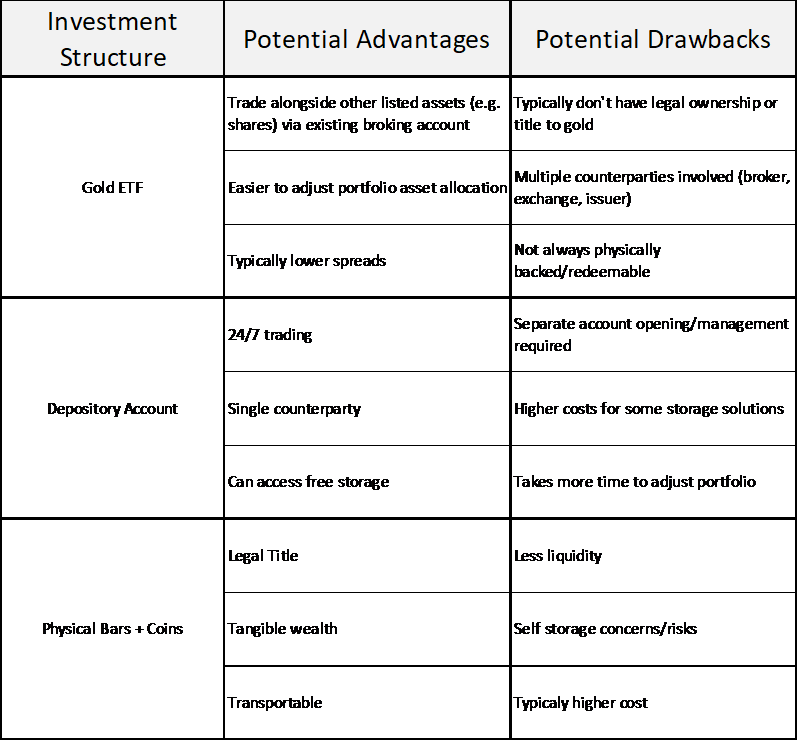Where to next for gold?
Over the past five years, the price of gold in Australian Dollars is up 58%; an impressive feat for an asset that produces no cashflows and has no credit risk. Ever-falling interest rates, central bank money printing, and political dysfunction have driven increased demand for the asset, while supply is relatively static.
More recently though, the ‘recovery trade’ in global markets has seen gold investors burned, with the price falling 4.7% in USD terms since June 2. For Australian investors it’s been even worse, down 11.1% since May 18. Is this the end of a bull market, or yet another case of ‘buy the dip’?
I recently reached out to four Livewire contributors to get a better understanding of what’s driving the gold price, the best ways to get exposure, and their outlook for the shiny metal. Comments come from Jordan Eliseo of The Perth Mint, Oscar Hutchinson from Fidelity International, Jon Deane of InfiniGold, and Kris Walesby from ETF Securities.
What’s driving the gold price?
Even after the recent pull-back, the returns on gold for Australian Dollar investors have been outstanding over the long term. Over the last five years, returns have averaged 9.6% p.a., and over 20 years, it’s been more like 8.6% p.a. So what’s behind these numbers?
For Jon Deane, it’s the pending risk of ‘stagflation’ that’s been the biggest driver. Stagflation occurs when inflation rises, despite anaemic economic growth – as seen in the 1970s.
Chart: Total Assets of The US Federal Reserve - millions of USD
.png)
“A global spike in money supply coupled alongside a move towards nationalism—and thus rolling back globalisation—are both highly inflationary and bullish catalysts for gold,” Deane said.
Deane also warns that with high levels of government, corporate, and personal debt, central bankers would be “dramatically hamstrung” in their ability to control an outbreak of inflation.
Oscar Hutchinson from Fidelity says the “textbook answer” is low real interest rates. When the inflation-adjusted return on a government bond is low or negative, the opportunity cost of holding gold is lower. He thinks there’s more at play though. “The shock and awe actions of central banks and governments have led investors to question the sustainability of debt levels and the monetary system,” he says.
Kris Walesby and Jordan Eliseo both echoed these sentiments, pointing to low bond yields and central bank action – neither of which looks likely to disappear anytime soon.
“Some of these factors were at play before COVID-19 rocked the global economy financial markets, with gold priced in USD rising by 45% between September 2018 and end May 2020,” Eliseo said.
Walesby also added that supply chain disruptions had affected the gold mining and refining industries too, with lockdowns and travel restrictions making delivery of physical metals challenging.
Risks to the bull thesis
With any investment thesis, there are always risks. Gold is no different. There were several risks that all or most of the contributors raised:
- A faster than expected economic recovery
- A rising USD and equity markets
- Lower inflation, or a deflationary event. (Your author notes, however, that gold performed well over the last decade, despite inflation repeatedly undershooting.)
“None of these things individually would necessarily stop the gold bull market in its tracks, but they are all potential headwinds,” Eliseo told us.
Has the easy money been made?
While it’s tempting to flee gold when trouble pops up, this may not always be the best approach. As we saw in early March, gold can sometimes fall in times of significant volatility as traders liquidate positions in order to meet margin calls. Instead, Kris Walesby advocates for taking a portfolio allocation approach to gold.
“We view gold as being a critical long-term component in a portfolio rather than a temporary trading product. We would generally advocate for investors to consider a permanent allocation range for gold where that allocation moves to the higher end in uncertain times and towards the lower end of the range in more stable markets,” Walesby said.
Eliseo also noted it was important to consider the overall portfolio. “At a portfolio level, investors know it’s about spreading risks as well as opportunities to capture upside,” he said.
For those with a more trading-focused approached though, the news appears positive. Jon Deane expects gold to remain a popular trade for the next two to three years. He added that he “wouldn’t be surprised to see gold trading at USD2,500 - 3,000 per oz over the medium term.” He said that a break above USD2,000 per oz could see a wave of new investors enter the market. He also seeing improving fundamentals, as asset managers begin to make gold a core allocation to their books.
What’s the outlook from here?
Jon Deane: The ongoing crisis coupled with the central banks’ bailout measures will fuel investors’ need for a safe haven. This coupled with eventual stagflation will lead to a furthering of gold’s price point. In 2-3 years, I imagine we’ll be looking at gold trading around USD2500-3000 per/oz.
Kris Walesby: Though we are seeing tentative signs for market recovery as lockdowns lift from COVID-19, we see the conditions as largely remaining favourable for gold in the next year. Governments expect and have planned for 2nd and even 3rd waves of COVID-19 infections which may be reflected by volatility in markets. Even aside from this, global lockdowns have had a significant effect on many sectors with resulting unemployment and it will take some time for the global economy to return to normal, whatever it may look like in the post-COVID world. From this perspective, there will still be periods of market uncertainty and central banks are likely to maintain low interest rates as well as consider ongoing quantitative easing measures which will support ongoing interest in and use of gold as a defensive asset.
Jordan Eliseo: Medium to long-term we are optimistic, and we suspect prices will remain biased to the upside for some time to come. Traditional low-risk assets now pay negative real returns and are set to do so for decades. Equities are at or near all-time highs in many markets and there is no consequence-free way to walk back from or indeed continue to move forward with unconventional monetary policy. There’s a reason gold has stood the test of time as an investment. It’s unlikely to be different this time.
Oscar Hutchinson: I have a long-term constructive view on gold because I see it as more likely than not that real rates stay low or negative for a fairly long period of time. Governments and central banks look like they are at the early stages of crossing the Rubicon on combinations of monetary and fiscal policy which might be ultimately expected to result in negative real returns from bonds or cash and encourage reallocation towards the security of gold, which does have a very long term track record of preserving purchasing power. The increase in negative-yielding debt globally represents a growing pool of assets that might prefer to seek out the comparatively higher 0% yield that gold offers!
How to invest in gold
There are four main ways to gain exposure to a rising gold price:
- Exchange-traded products that offer exposure to the gold price.
- A depository account. This is like a bank account for gold.
- Physical gold bullion. This can be either through actual bars or coins, which can be purchased and stored in a vault - or buried in your back yard if that's your thing.
- Gold mining companies. These will be addressed specifically in a separate piece to be released later this week. Hit the “Follow” button to the left to be notified when this is released.
For the first two categories, Jordan Eliseo has provided a handy table:

Source: The Perth Mint
Note on this table from The Perth Mint: For those using either an ETF or a depository account, it’s also a good idea to check the history and risk profile of the custodian and/or product issuer, given they are responsible for safeguarding your investment.
Kris Walesby from ETF Securities points to the ease of access and liquidity of ETFs, but warns investors to consider trading risks and the structure of the ETF.
“For example, is the gold allocated (whereby investors have 100% ownership over the holdings) or unallocated (where investors interests may also be shared with other parties). ETFS Physical Gold (ASX code: GOLD) uses allocated gold and investors can redeem their unit holdings for the physical gold bullion if they choose,” said Walesby.
 Source: ASX Investment Products Monthly Update, May 2020
Source: ASX Investment Products Monthly Update, May 2020Jon Deane spoke of the emergence of technological solutions to access gold. “Retail investors have traditionally accessed the gold market via ETFs, Warrants, and Futures, using existing rails in the securities markets. However, the emergence of technology solutions like Perth Mint GoldPass enables investors to access gold markets directly from The Mints —reducing costs and friction in the market. As technological solutions continue to evolve and client-facing enterprises build infrastructure to support new solutions, we should anticipate value shifting to cheaper and more efficient entry points.”
In conclusion
There are plenty of reasons to like gold and consider an allocation in a diversified portfolio. Gold offers a defensive asset with no credit risk or counterparty risk and a long-term history of capital growth.
For Australian investors, there are a wide range of options to access exposure to the gold price in either Australian or US Dollars.
“There’s a reason gold has stood the test of time as an investment. It’s unlikely to be different this time” – Jordan Eliseo.
But what about the miners?
In part two of this series, we look at the opportunities in gold mining companies (and the hopefuls). Hit the “FOLLOW” button below to be notified when I post the wire.
Not a Livewire member yet? Sign up today to get free access to investment ideas and strategies from Australia's leading investors
1 topic
3 stocks mentioned
2 contributors mentioned


